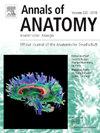重新审视山羊(Capra hircus)胸神经和臂丛神经环路的解剖结构。
IF 1.7
3区 医学
Q2 ANATOMY & MORPHOLOGY
引用次数: 0
摘要
背景:我们重新研究了胸神经和腋动脉上两个神经环路的解剖结构,以补充目前的一般描述,并论证有助于形成胸神经环路的神经是否为头颅胸神经。此外,在解剖的同时,还研究了头皮肌与臂丛神经根之间的位置关系,这也是本研究的目标神经:方法:本研究使用大体解剖法对 10 只家养成年山羊(8 只雌性和 2 只雄性)的 20 条臂丛神经进行了检查:结果:在许多解剖中(95%),发现鳞状腹肌的最后一束穿过 C7 和 C8 的根部之间,将臂丛分为头侧(腹侧)和尾侧(背侧)两部分。在腋动脉周围形成的第一个神经环中有两条胸神经。在70%的解剖中,第一条胸神经主要来自C6和C7的腹侧分支,与胸大肌(n. musculocutaneus)伴生;而在其余30%的解剖中,第二条胸神经直接来自C8,或作为胸侧神经(n. thoracicus lateralis,C8,T1)的第一分支。在神经环路之后,第二胸神经分支支配胸大肌浅表,向其插入处延伸。研究发现,锁骨下神经的神经支配来自多个来源,包括臂丛神经的腹侧分支。有趣的是,在 14 例解剖中的 4 例中,发现了迄今为止在动物解剖学文献中尚未发现的锁骨下肌和膈肌之间的沟通。在 20 例解剖中的 16 例(60%)中,正中肌近侧的横纹肌在第二神经环路腋窝的位置接受了来自正中肌的沟通分支:结论:有助于形成胸肌环的第二胸神经最好称为尾胸神经,而不是颅胸神经。除了从进化角度看问题外,了解这项研究的结果对兽医解剖学教学也有帮助。本文章由计算机程序翻译,如有差异,请以英文原文为准。
Revisiting the anatomy of the pectoral nerves and nerve loops of the brachial plexus in the goat (Capra hircus)
Background
The anatomy of the pectoral nerves and the two nerve loops on the course of the axillary artery was revisited to complement current general descriptions as well as to argue whether the nerves contributing to the formation of the pectoral loop are the cranial pectoral nerves. Besides, the positional relationship between the scalene muscles and the nerve roots of the brachial plexus, which contribute to the nerves aimed in this study, was also examined at the same time as the dissection.
Methods
Twenty brachial plexuses of 10 domestic adult goats (8 females and 2 males) were examined using gross dissection in this study.
Results
In many dissections (95 %), the last bundle of scalenus ventralis muscle was found to pass between the roots of C7 and C8, dividing the brachial plexus into the cranial (ventral) and caudal (dorsal) parts. Two pectoral nerves were noted to contribute to the formation of the first nerve loop around the axillary artery. The first pectoral nerve arose predominantly from the ventral branches of C6 and C7 in company with the n. musculocutaneus, while the second pectoral nerve arose directly from C8 in 70 % of the dissections or as the first branch of the n. thoracicus lateralis (C8, T1) in the remaining 30 %. After the nerve loop, the second pectoral nerve branched off to innervate the superficial surface of the m. pectoralis profundus toward its insertion. The m. subclavius was found to receive its innervation from several sources, including the ventral branches of the brachial plexus. Interestingly, in 4 of the 14 dissections a communication between the n. subclavius and the n. phrenicus heretofore not found in the animal anatomy literature was found. In 16 of the 20 dissections (60 %), the ramus muscularis proximalis of the n. musculocutaneus received the communicating branch(s) from the n. medianus at the site of the second nerve loop, ansa axillaris.
Conclusion
The second pectoral nerve contributing to the pectoral loop would be better described as the caudal pectoral nerve rather than the cranial pectoral nerve. Besides the evolutionary perspectives, understanding the findings of this study would be helpful for teaching veterinary anatomy.
求助全文
通过发布文献求助,成功后即可免费获取论文全文。
去求助
来源期刊

Annals of Anatomy-Anatomischer Anzeiger
医学-解剖学与形态学
CiteScore
4.40
自引率
22.70%
发文量
137
审稿时长
33 days
期刊介绍:
Annals of Anatomy publish peer reviewed original articles as well as brief review articles. The journal is open to original papers covering a link between anatomy and areas such as
•molecular biology,
•cell biology
•reproductive biology
•immunobiology
•developmental biology, neurobiology
•embryology as well as
•neuroanatomy
•neuroimmunology
•clinical anatomy
•comparative anatomy
•modern imaging techniques
•evolution, and especially also
•aging
 求助内容:
求助内容: 应助结果提醒方式:
应助结果提醒方式:


